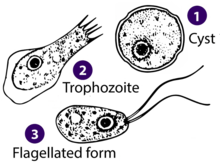
Back Naegleria Catalan Naegleria Spanish Naegleria French Naegleria Galician Naegleria ID Naegleria Italian ネグレリア Japanese 나이글레리아속 Korean Naegleria Turkish Naegleria Vietnamese
| Naegleria | |
|---|---|

| |
| Different stages of Naegleria fowleri | |
| Scientific classification | |
| Domain: | Eukaryota |
| Phylum: | Percolozoa |
| Class: | Heterolobosea |
| Order: | Schizopyrenida |
| Family: | Vahlkampfiidae |
| Genus: | Naegleria |
Naegleria /nɛˈɡlɪəriə/ is a genus consisting of 47 described species of protozoa often found in warm aquatic environments as well as soil habitats worldwide.[1] It has three life cycle forms: the amoeboid stage, the cyst stage, and the flagellated stage, and has been routinely studied for its ease in change from amoeboid to flagellated stages.[1] The Naegleria genera became famous when Naegleria fowleri, the causative agent of the usually fatal human and animal disease primary amoebic meningoencephalitis (PAM), was discovered in 1965.[1] Most species in the genus, however, are incapable of causing disease.[1]